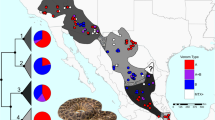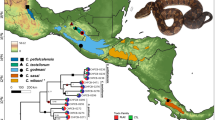Abstract
VENOM composition within snake species can show considerable geographical variation1, an important consideration because bites by conspecific populations may differ in symptomatology and require different treatments2–5. The underlying causes of this phenomenon have never been explained. Here we present evidence that the variation in the venom of the pitviper Calloselasma rhodostoma (Serpentes: Viperidae) is closely associated with its diet. We also evaluated other possible causes of geographic variation in venom using partial Mantel tests6–10 and independent contrasts11, but rejected both contemporary gene flow (estimated from geographical proximity) and the phylogenetic relationships (assessed by analysis of mitochondrial DNA) among populations as important influences upon venom evolution. As the primary function of viperid venom is to immobilize and digest prey12–14 and prey animals vary in their susceptibility to venom15,16, we suggest that geographical variation in venom composition reflects natural selection for feeding on local prey.
Similar content being viewed by others
References
Chippaux, J.-P., Williams, V. & White, J. Toxicon 29, 1279–1303 (1991).
Barrio, A. & Brazil, O. V. Acta physiol. Lat. Am. 1, 291–308 (1951).
Warrell, D. A. in Natural Toxins: Animal, Plant and Microbial. (ed. Harris, J. B.) 25–45 (Clarendon, Oxford, 1986).
Jayanthi, G. P. & Veerabasappa Gowda, T. Toxicon 26, 257–264 (1988).
Wüster, W., Otsuka, S., Malhotra, A. & Thorpe, R. S. Biol. J. Linn. Soc. 47, 97–113 (1992).
Brown, R. P., Thorpe, R. S. & Baez, M. Nature 352, 60–62 (1991).
Thorpe, R. S. & Baez, M. Biol. J. Linn. Soc. 48, 75–87 (1993).
Thorpe, R. S., et al. in Phylogenetics and Ecology (eds. Eggleton, P. & Vane-Wright, R.) 189–206 (Linnean Soc. Symp. Ser. No. 17, Academic, London 1994).
Castellano, S., Malhotra, A. & Thorpe, R. S. Biol. J. Linn. Soc. 52, 365–375 (1994).
Thorpe, R. S. Malhotra, A., Black, H., Daltry, J. C. & Wüster, W. Phil. Trans. R. Soc. Lond. B349, 61–68 (1995).
Felsenstein, J. Am. Nat. 125, 1–15 (1985).
Thomas, R. G. & Pough, F. H. Toxicon 17, 221–228 (1979).
Mackessy, S. P. Copeia 1988, 92–101 (1988).
Hayes, W. K. Toxicon 29, 867–875 (1991).
Minton, S. A. & Minton, S. R. Venomous Reptiles (Scribners, New York, 1969).
Elliott, W. B. in Biology of the Reptilia, Physiology B vol. 8 (eds Gans, C. & Gans, K. A.) 163–435 (Academic, London, 1978).
Tan, N.-H. Tropical Biomedicine 8, 91–103 (1991).
Tu, A. T. & Adams, B. L. Nature 217, 761–762 (1968).
Foote, R. & MacMahon, J. A. Comp. Biochem. Physiol. 57B, 235–241 (1977).
Chen, Y., Wu, X. & Zhao, E. Toxicon 22, 53–61 (1984).
Pough, F. H. & Groves, J. D. Am. Zool. 23, 443–454 (1983).
Boche, J., Chippaux, J. P. & Courtois, B. Bull. Soc. Path. Exot. 74, 356–366 (1981).
Gregory-Dwyer, V. M., Egan, N. B., Bianchi Bosisio, A., Righetti, P. G. & Russell, F. E. Toxicon 24, 995–1000 (1986).
Tu, A. T. & Ganthavorn, S. J. Herpet. 12, 105–107 (1978).
Kocher, T. D. et al. Proc. natn. Acad. Sci. U.S.A. 86, 6196–6200 (1989).
Moritz, C., Schneider, C. J. & Wake, D. B. Syst. Biol. 41, 273–291 (1992).
Felsenstein, J. PHYLIP version 3.3 (Univ. Washington, Seattle, 1990).
McElroy, D., Moran, P., Bermingham, E. & Kornfield, I. Restriction Enzyme Analysis Package version 4.0 (Univ. Maine, Massachusetts, 1992).
Rice, W. R. Evolution 43, 223–225 (1989).
Author information
Authors and Affiliations
Rights and permissions
About this article
Cite this article
Daltry, J., Wüster, W. & Thorpe, R. Diet and snake venom evolution. Nature 379, 537–540 (1996). https://doi.org/10.1038/379537a0
Received:
Accepted:
Issue Date:
DOI: https://doi.org/10.1038/379537a0
- Springer Nature Limited
This article is cited by
-
Snakes on a plain: biotic and abiotic factors determine venom compositional variation in a wide-ranging generalist rattlesnake
BMC Biology (2023)
-
Dynamic genetic differentiation drives the widespread structural and functional convergent evolution of snake venom proteinaceous toxins
BMC Biology (2022)
-
Intraspecific variation of cuticular hydrocarbons and apolar compounds in the venom of Ectatomma brunneum
Chemoecology (2020)
-
Recent advances in snake venom proteomics research in India: a new horizon to decipher the geographical variation in venom proteome composition and exploration of candidate drug prototypes
Journal of Proteins and Proteomics (2019)
-
Peptidomic investigation of Neoponera villosa venom by high-resolution mass spectrometry: seasonal and nesting habitat variations
Journal of Venomous Animals and Toxins including Tropical Diseases (2018)





